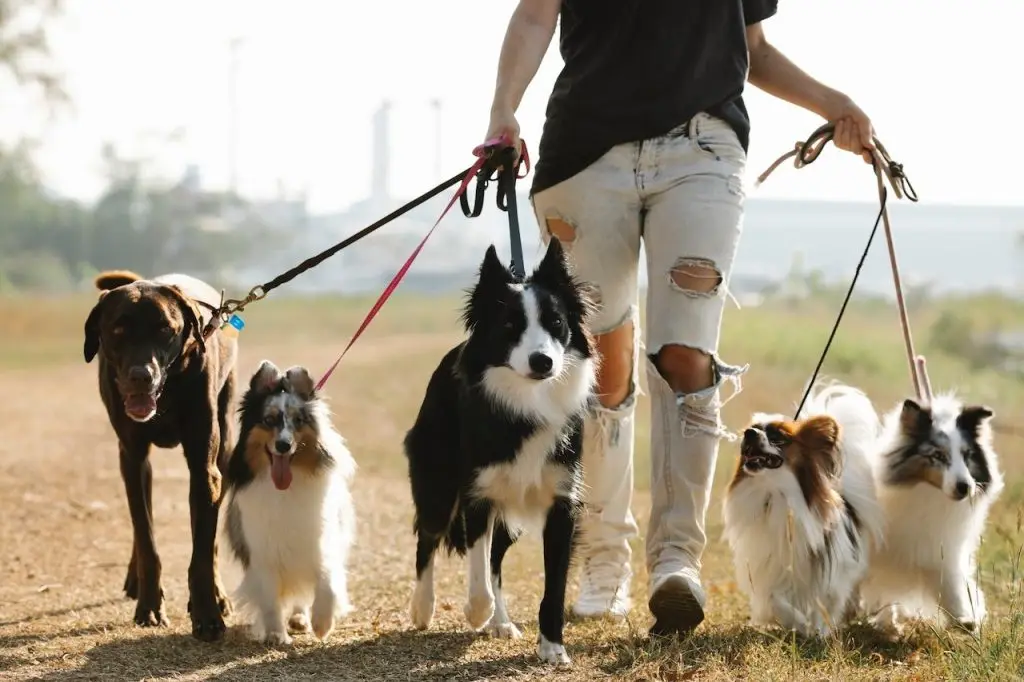Lost pets come home with Peeva.
Aggression in dogs

Dogs, renowned for their loyalty and companionship, are intricate beings with a myriad of emotions. But like all creatures, dogs too can exhibit aggression. Understanding this behavior is pivotal for ensuring the safety and well-being of both the canine and its human counterparts. This guide aims to provide a comprehensive overview of dog aggression, encompassing its signs, treatment, prevention, and addressing commonly posed inquiries.
Understand the roots of aggression in dogs and find effective training techniques in our educational piece.
Signs of Aggression in Dogs

1. Growling and Snarling:
Perhaps the most conspicuous sign of aggression, growling and snarling serve as an audible warning. The dog is communicating discomfort, fear, or a desire to establish dominance. While it might be tempting to reprimand the dog for such behavior, it’s vital to understand that growling is a preventive measure before more severe actions like biting.
2. Showing Teeth:
When a dog bares its teeth, it’s generally not because they’re offering a smile. It’s a defensive stance, signaling a heightened state of alertness or discomfort.
3. Stiffening of the Body:
A subtle yet distinct sign is the sudden rigidity in a dog’s posture. If a normally relaxed dog suddenly tenses up when approached or touched, it may be signaling distress or aggression.
4. Intense Staring:
Direct, unyielding eye contact from a dog, especially towards another dog, is a sign of establishing dominance or issuing a challenge. It can precede more overt signs of aggression.
5. Raised Hackles:
This refers to the hair along a dog’s spine standing on end. Raised hackles are an instinctual response and indicate that a dog is intensely aroused, often due to fear, anger, or excitement.
6. Snapping or Biting:
Snapping in the air or actual biting are definitive aggressive actions. Biting can range from nips that don’t break the skin to more severe bites. Any bite, regardless of its severity, signifies a problem that necessitates intervention.
7. Lunging or Charging:
Even if the dog doesn’t make physical contact, a sudden lunge or charge towards a person or another animal indicates aggressive intent.
It’s worth noting that not all aggressive behaviors are malignant in intent. For instance, during play, dogs might exhibit some behaviors like growling or mouthing that might seem aggressive. Hence, context plays a paramount role in discerning playful behavior from genuinely aggressive behavior. Understanding the circumstances surrounding the aggression aids in determining its root cause.
Every dog is an individual, and what might be a standard response for one might not be for another. Hence, understanding your dog’s personality, recognizing deviations from their norm, and consulting with professionals can aid in correctly identifying aggression.
When it comes to handling aggressive behavior in dogs, there’s no one-size-fits-all solution. Each dog is unique, with individual triggers and thresholds for aggression. Understanding these factors and tailoring treatment to each specific dog is crucial for achieving the desired outcome. Below, we delve into several treatment options to consider:
1. Professional Training:
A trained canine behaviorist or dog trainer can work wonders in mitigating aggressive tendencies. They can evaluate the dog, identify the root causes of aggression, and recommend personalized training exercises. The emphasis here is on positive reinforcement, teaching the dog appropriate behaviors without resorting to punishment or negative techniques.
2. Dog Aggression Camps:
Dog aggression camps, often referred to as “boot camps”, are intensive training programs where dogs stay for a specified period, receiving daily training sessions from professionals.
Benefits:
Structured Environment: These camps provide a regimented, controlled environment, ensuring consistency in training.
Professional Expertise: Trained personnel at these camps have extensive experience dealing with aggressive dogs and can employ specialized techniques to curb unwanted behaviors.
Socialization: Aggression camps often include group training sessions, allowing dogs to socialize with others under controlled conditions.
It’s imperative to research and select a reputable camp that uses humane, positive reinforcement techniques.
3. Dog Grooming for Aggressive Dogs:
Aggressive dogs require special care during grooming, given their potential to lash out. Some grooming facilities specialize in handling such dogs.

Benefits:
Trained Groomers: These facilities have groomers trained to handle aggressive dogs with care and patience, ensuring a stress-free grooming session.
Safety Measures: Specialized equipment like muzzles or sedatives (administered under veterinary guidance) can be used if deemed necessary.
Behavioral Improvement: Regular exposure to grooming can acclimatize the dog to the process, potentially reducing aggression over time.
It’s essential to inform the groomer beforehand about your dog’s aggressive tendencies and any known triggers.
4. Medication:
In some cases, medication can be beneficial in treating aggression. These can range from anti-anxiety drugs to mood stabilizers. However, medication should be seen as a part of a comprehensive treatment plan and not a sole solution. Always consult with a veterinarian before administering any medication.
5. Behavioral Modification:
This involves changing a dog’s reaction to stimuli that trigger aggression. For instance, if a dog reacts aggressively to strangers, a behavioral modification plan might involve gradually exposing the dog to strangers in a controlled manner, rewarding calm behavior, and gradually reducing the dog’s fear or aggression.
6. Neutering or Spaying:
For some dogs, especially males, neutering can reduce aggressive tendencies, particularly those linked to hormonal factors.
In conclusion, while dog aggression can be challenging, it’s crucial to remember that with patience, understanding, and the right interventions, most aggressive behaviors can be managed or even completely rectified. Whether it’s through specialized training, camps, grooming sessions, or other treatments, every dog deserves the chance to live a calm, happy life. The next section will delve into prevention techniques to reduce the likelihood of aggressive behaviors developing in the first place.
Prevention of Aggression in Dogs
Aggression in dogs, while it can be addressed, is far easier to prevent. Instituting preventative measures early on, especially during a dog’s formative years, can significantly curtail the development of aggressive tendencies. By understanding and applying these strategies, owners can foster a harmonious and safe environment for both their dogs and those around them.
1. Early Socialization:
The Crux of Canine Harmony. Introducing puppies to a variety of experiences, sounds, sights, and people during their early stages (typically between 3 to 14 weeks of age) can play a pivotal role in their development. This exposure helps them understand and adapt to different situations, reducing the likelihood of fear or aggression later on.
2. Consistent Training:
Laying the Groundwork. Enroll puppies in obedience classes, ensuring they’re taught by trainers who employ positive reinforcement techniques. Not only does this instill good behavior, but it also strengthens the bond between the owner and the dog, emphasizing the owner’s role as a gentle leader.
3. Understand Canine Body Language:
A Dialogue Without Words. Dogs communicate primarily through body language. Recognizing signs of discomfort, fear, or stress allows for timely intervention, potentially preventing an aggressive response.
4. Regular Health Check-ups:
A Healthy Dog is a Happy Dog. Regular veterinary check-ups can identify potential health issues that might cause discomfort or pain, leading to aggression. For instance, a dog with an ear infection might snap when its head is touched due to the pain.
5. Adequate Exercise:
Expelling Excess Energy. Regular exercise ensures that dogs expend pent-up energy, reducing restlessness and potential aggression. The type and amount of exercise will vary depending on the breed and age of the dog.
6. Positive Reinforcement:
Celebrating Good Behavior. Rewarding dogs for positive behavior, rather than punishing them for negative actions, fosters a positive environment. Positive reinforcement can be in the form of treats, praises, or playtime.
7. Neuter/Spay Early:
Keeping Hormonal Aggression at Bay. Neutering or spaying dogs can prevent aggression arising from hormonal causes. It’s advisable to consult with your vet about the right age for this procedure for your specific breed.
8. Avoid Negative Training Techniques:
Building Trust, Not Fear. Techniques that involve dominance or fear can exacerbate aggressive tendencies. Tools like shock collars or methods like alpha rolls can increase aggression instead of curbing it.
9. Monitor Playtime:
Safe Fun for All. When dogs play, it’s crucial to ensure it doesn’t escalate into aggression. Supervise play sessions, especially with unfamiliar dogs or in new environments.
In the world of canines, prevention is indeed worth a pound of cure. Establishing a foundation built on understanding, trust, and positive interactions can significantly mitigate the risks of aggressive behavior manifesting. By being proactive and embracing these preventative measures, dog owners can pave the way for a harmonious coexistence with their furry companions.
Frequently Asked Questions (FAQ):
Are pregnant dogs aggressive?
Pregnant dogs, or those experiencing pseudopregnancy, might exhibit changes in behavior, including increased protectiveness, mood swings, or even mild aggression. This behavior change is often due to hormonal shifts, the instinct to protect potential offspring, or discomfort during pregnancy. Always approach pregnant dogs with care and understanding, and consider consulting a veterinarian if behavioral changes are concerning.
Why are brindle dogs more aggressive?
The brindle coloration in dogs is merely a coat pattern and is not directly linked to temperament or behavior. However, the perception of brindle dogs being more aggressive might stem from certain breeds that have brindle coats and are stereotypically viewed as aggressive. It’s essential to understand that temperament is influenced by various factors like genetics, upbringing, socialization, and individual personality rather than just coat color.
Can you board an aggressive dog?
Boarding an aggressive dog can be challenging, but it’s not impossible. Many specialized boarding facilities cater specifically to dogs with behavioral issues, including aggression. If you need to board an aggressive dog, communicate your dog’s specific behaviors, triggers, and needs to the facility upfront. It’s crucial to choose a facility that has experienced staff trained to handle such dogs and can ensure your pet’s safety and well-being during their stay.
Are Chow dogs aggressive?
Chow Chows are often perceived as aloof or reserved, especially with strangers. While they can be fiercely loyal and protective of their owners, they may also exhibit territorial behavior. This breed’s temperament can sometimes be misunderstood as aggression. Proper training, early socialization, and understanding the breed’s characteristics are essential to ensure a well-adjusted and sociable Chow Chow. It’s always recommended to approach unfamiliar dogs, including Chows, with caution and respect.
Peeva: Where Lost Pets Find Their Way Home
Transform your pet’s microchip into a lifeline. 24/7 phone support and lost pet alerts ensure your pet gets the help they need, when they need it.
You Might Be Interested In
- Health, Wellness, Nutrition, Training
- Health, Wellness, Nutrition, Training






